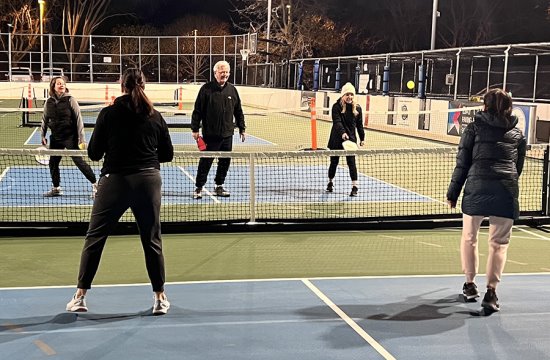
| ||||||
In the last two years, pickleball participation has grown by 39.3% to just under 5 million participants nationwide and The Sports and Fitness Industry Association announced it "as the fastest-growing sport in America for the second year in a row."
There are now more than 10,000 registered pickleball facilities in the United States, according to USA Pickleball, the sport's governing body. "Pickleball's growth trajectory gives every indication it will be a significant part of the American sport landscape for the foreseeable future," said Tom Cove, President/CEO of the Sports and Fitness Industry Association.
Lamorinda has seen a similar growth in popularity for the sport, with courts now made available at the Lafayette Community Center, four courts out of 12 at Northgate High School converted to dual use, the Lafayette Tennis Club, and the Walnut Creek Pickleball Club among other sites.
So what is the issue that has come to loggerheads between the tennis and pickleball communities? Access and space.
The Lafayette Pickleball Club has 326 members, and the Walnut Creek Pickleball club has 726 members. Budd MacKenzie, a member of the Lafayette community, has for the last year, been trying to get Acalanes High School to convert three of their six tennis courts into dual use courts with pickleball, though if approved, they would only start with one court.
MacKenzie is leading a network of Lafayette pickleball players, many who play at the Lafayette Community center that has eight oversubscribed courts because there are far more pickleball players than courts.
The North Coast Section let it be known that there was not an issue in having the tennis courts lined for dual purposes and MacKenzie said that fundraising for the laying out of the additional lines - which would cost approximately $3,000 - would not be an issue.
"I was disappointed that the approval was for only one court but rather than argue, I wrote asking where to send the check," MacKenzie said.
The third and most telling issue was for the school's tennis community (coaches and players) to agree to the additional lines on the court.
MacKenzie has been dealing with a number of the Acalanes school district administrators. John Nickerson, the superintendent of the Acalanes Union High School District, is also a pickleball player. "I started playing about a year ago and it's a whole lot of fun," Nickerson said. "You can be a complete novice and be pretty good in about an hour."
Nickerson then approached the Acalanes tennis community (coaches and players) about the idea of having at least one court being lined for pickleball as well. "Initially they said that we could try it on one court but when they saw the design, their response was `Absolutely not,'" Nickerson said. "It would be way too confusing, disruptive, and problematic. The board's position (and I support their position) is that our facilities are for the community but their primary purpose is for the educational and the extracurricular programming of the students."
Acalanes does have a form of pickleball that is played during gym classes. "Our P.E. department has played pickleball on our tennis courts without the pickleball lines for well over a decade," Nickerson said. "They use the regular tennis nets, and it is a different looking game."
Haley Walsh, one of Acalanes' athletic directors, echoed the feeling of the tennis team as regards to the extra lines on the tennis courts. "Where the lines are called by the players, we don't want there to develop animosity if there are problems calling the ball in or out," Haley said. "Our coaches said that it would be difficult to play on a dual court because of the confusion of the lines. We really have to support our coaches and the programs that are established at the school."
MacKenzie, a former tennis coach, does not see the additional lines being an issue. "The lining of the tennis courts is white and the lines for pickleball would be dark blue so it really would not be an issue in a tennis match," MacKenzie said.
MacKenzie points to the universal appeal of pickleball. "It's become an every-person's sport," Mackenzie said. "It's for athletes but also for kids that normally don't get much exercise and seniors that use the sport to get their exercise and social interaction where previously they did this mostly by walking the reservoir."
Lafayette resident Michelle Holcenberg, a tennis and pickleball player herself, sees it as a family sport. "My son started playing when he was 10 and has even played in tournaments with adults."
Nickerson suggested that if the pickleball powers that be were willing to do the striping and get the netting, the elementary schools might be very interested in allowing their blacktops to be used. MacKenzie did not see that as workable because the surfaces are not level like a tennis court and with homes so near the elementary schools, the noise level of the game would prove to be too much a distraction for those residents.
Ultimately the issue is not the value of the sport by any of the concerned parties. "The board would like to support community interest but they just feel that right now there is such opposition from the student programs," Nickerson said. "We haven't heard any support coming from the general student body that this is something that we need on our campus."
Though continuing to try and find a way to work things out with the school, MacKenzie remains frustrated at the attitude of the Acalanes tennis community. "If creating dual purpose courts is to be based solely upon the input of the Acalanes tennis teams, there will never be a choice at the high school."
Reach the reporter at:
